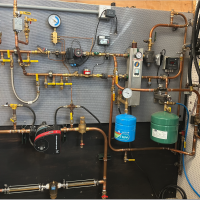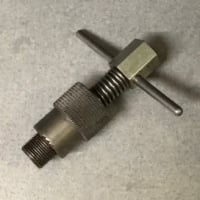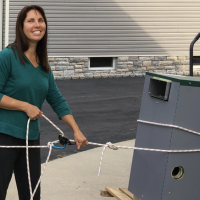Need best solution for getting hot water for shower
The main problem is that my tank is 53 gallons (family size) and I'm just one person. I can get by on a rather small amount of hot water, like taking a full shower once every 3 days. I don't mind heating a small amount of water on the stove to wash dishes. Getting shower water is my main goal. The water heater is an unheated basement. The shower is on the second floor.
Ideas I've considered:
(1) Insulating the current tank: I have not done this yet because it won't solve the problem of heating 53 gallons 24 hours a day when I only need a few gallons every three days for showers. Yes, I realize that the tank doesn't actually run all day, but my electric bill went way down when I turned the heater off.
(2) Turning the breaker on for one hour every three days: I'm concerned about Legionnaire's disease as the water would cool down to the danger zone between uses. Some claim that a temperature of 140 degrees kills Legionnella bacteria in 32 minutes, so that might be a solution. I have not verified this claim in scientific studies. The question is, how to know that the water at the top of the tank has reached 140.
(3) 3-day timer: same concern about Legionnaire's
(4) Wall switch to make it easier to turn the heater on and off from upstairs: Same concern about Legionnaires, plus I heard something about fire safety concerns with a wall switch.
(5) Getting water from the oil boiler via the existing tankless coil (aquastat has been turn off in favor of the electric water heater): I determined that burning oil for hot water is more expensive than electricity.
Question: Is there a way to use the current water heater that is safe in terms of health and fire hazard + saves electricity + is convenient?
If not, I'm looking for a new way of getting hot water that is affordable for the unit, installation, and use and convenient. Getting a much smaller electric tank would make sense, but the unit and installation seem expensive. I've looked at mini tanks and instant devices. At this point I'm confused and could use some guidance. When I say I'm a low-income person, I mean that a solution that costs $400 or more isn't within my reach. Thank you very much for your wisdom and ideas!
Comments
-
Hi, First thing that comes to mind is to disconnect the lower element in the tank. You would simply put wire nuts on both wires after removing them from the element. This is 240 volts, so unless you're familiar with power that can kill, get someone who is skilled and has the right tools, (like a meter) to do this work. Doing this essentially makes the tank smaller, by only using the upper element. Insulate both hot and cold pipes above the tank as they are often a constant source of heat loss. Use a low flow showerhead. 1.5 gallons per minute works fine if you use a good showerhead. Some people find that one gpm works for them.
This is a start and might be all that you need to make things work. Please do let us know how it goes.
Yours, Larry2 -
Heat pump water heater. Mine uses a couple kilowatt-hours per day so about 30 cents. It’s magically cheap. See if your state offers incentives to install one. I got a several hundred dollar check from New Jersey and they they didn't even mind that I installed it myself (had to be permitted and inspected of course)
NJ Steam Homeowner.
Free NJ and remote steam advice: https://heatinghelp.com/find-a-contractor/detail/new-jersey-steam-help/
See my sight glass boiler videos: https://bit.ly/3sZW1el1 -
-
In addition to insulating the hot and cold pipes near the water heater as @Larry Weingarten suggests, consider getting heat traps if you don't already have them.
0 -
There are shower heads that are point of use that are electric plug-in. How about the YMCA?0
-
-
Thanks, Larry! I wasn't aware that running only the top element was a possibility. I found this explanation: "Once the water at the top of the tank reaches the temperature indicated by the thermostat, the top element will turn off, and the bottom element will turn on. The bottom element will then heat the rest of the water in the tank to the desired temperature."Larry Weingarten said:Hi, First thing that comes to mind is to disconnect the lower element in the tank. You would simply put wire nuts on both wires after removing them from the element. This is 240 volts, so unless you're familiar with power that can kill, get someone who is skilled and has the right tools, (like a meter) to do this work. Doing this essentially makes the tank smaller, by only using the upper element. Insulate both hot and cold pipes above the tank as they are often a constant source of heat loss. Use a low flow showerhead. 1.5 gallons per minute works fine if you use a good showerhead. Some people find that one gpm works for them.
This is a start and might be all that you need to make things work. Please do let us know how it goes.
Yours, Larry
That means that while the top element is running, the bottom element is not running, correct? I think you're suggesting that I leave the tank on 24/7. Will this actually result in savings, and if so, why?
The hot water at the top will be mixing with the cold water in the middle and at the bottom, so at some point the top element will come on to restore the temperature. Are you saying that the top element will only be heating the top third, and that will result in savings?
0 -
I saw these plug-ins on YouTube. They don't look safe? I believe they're widely used in Southeast Asia, where they're referred to as "suicide showers."Jon_blaney said:There are shower heads that are point of use that are electric plug-in. How about the YMCA?
0 -
I don't believe there's any leak. $8 a month would be fine, but I don't think that's what it would cost. The question is not the cost of the showers, but the cost of running the water heater 24/7 just to take a shower every couple of days.Hot_water_fan said:I think there's something else going on - a ten minute, 2gpm shower every 3 days is about $8/month at $.2/kwh. Is there a leak somewhere?
I have not been able to find any estimates for how many hours a day a 53-gallon tank would run to provide one shower every couple of days. Everything I've found is based on high usage for a family, not a single person.
Here are my figures based on the heater running 1 hour per day (but I have no idea if it would actually run 1 hour per day!). Please let me know if I've got this wrong:
4000 watt heater = 4 kWh per hour
1h/day = 120 kWh per month
Electric rate: 26 cents per kWh (supply + delivery, etc.)
120 kWh x .26 = $31 per month
So the questions are (1) how many hours a day would the heater actually run, and (2) how much could I lower the run time with changes like insulating the tank and pipes and running only the top element? If I could make that work, it would avoid investing in a better but more expensive to install system.
0 -
Too many variables to give you an exact answer. How cold is your incoming water, how cold is the space around the heater, how often do you use hot water. You could buy an energy meter if you want an exact answer.
Regardless the things you can do are, lower the temperature in the tank, add insulation, determine a schedule to turn it off, assure all fixtures are low flow, showers any sink faucet could be reduced to . 35 gpm, shower to 1.5 gpm. Change the elements to 3000w from the typical 4500w.
The caution with turning it off for periods is the recovery time. It could take an hour or more to get hot water if you turn it off at night. Based on how cold the incoming water is.
In many northern areas city water temperature drops into the 30 degree range. Heating 50 gallons to 120 or more will take time.
Take a bucket to all fixtures and determine flow rate, replace the aerators on sinks with high flow. Add insulation blankets available from home centers. These would be inexpensive, I immediate upgrades.
Timers, element replacements would be more involved and $$Bob "hot rod" Rohr
trainer for Caleffi NA
Living the hydronic dream0 -
You’re confusing yourself a bit - the issue is not heating a 30 gallon or 53 gallon or 80 gallon tank - that’s all the same amount of energy over the course of a month. Same with turning off one element - energy used doesn’t change. The issue is standby loss. I suspect your tank actually has pretty low standby loss - should be well under 4kwh per day. (A 50 gallon tank on Home Depot has about 31 sqft of surface area. Assuming a 40 degree space and 120 degree water with R-12 insulation, that’s only $11/month or 1.5 kwh/day). You could add an insulation blanket and probably drop that a bit further as well as add pipe insulation cheaply.0
-
Hi @Hemlock , All modern electric heaters use “non-simultaneous “ operation. It means only one element can come on at a time. Using only the top element essentially shrinks the tank. This results in less heat loss from the tank because around half of it is cold inside. Hot water floats on cold water. It stratifies in the tank and mixes very little. The more and better the insulation is around the tank and plumbing, the less important a timer is. For example, if the well insulated tank lost only one degree in a day, what would a timer really save? Good tanks lose six degrees in a day. Anyway, I’d go a little crazy with insulation and then see if a timer is needed. 😎
Yours, Larry0 -
Larry, that's so interesting and helpful! I didn't realize any of that. OK, I will insulate the tank and see what the result is. Can you post a link to the insulation you suggest? I have a roll of house insulation, but I assume I can't use that?Larry Weingarten said:Hi @Hemlock , All modern electric heaters use “non-simultaneous “ operation. It means only one element can come on at a time. Using only the top element essentially shrinks the tank. This results in less heat loss from the tank because around half of it is cold inside. Hot water floats on cold water. It stratifies in the tank and mixes very little. The more and better the insulation is around the tank and plumbing, the less important a timer is. For example, if the well insulated tank lost only one degree in a day, what would a timer really save? Good tanks lose six degrees in a day. Anyway, I’d go a little crazy with insulation and then see if a timer is needed. 😎
Yours, Larry
The heater has been off for the last four months except for a single day when I turned it on for one hour. I will begin by making sure the heater is turned to 140 degrees to kill any Legionella bacteria. Any other health concerns I should be aware of when restarting the heater?0 -
This might be a good option for you @Hemlock https://forum.heatinghelp.com/discussion/190406/antique-water-heater-the-hoffman-company#
Edward Young Retired
After you make that expensive repair and you still have the same problem, What will you check next?
0 -
Update: I have now read several scientific studies on Legionella in water heaters and there seems to be good consensus that it dies at 140 degrees and that 120 is not hot enough. One study found that it needs to be at 140 degrees for 32 minutes. I would love to turn my water heater on and off with the breaker if this can be done safely (in terms of bacteria) and without damaging anything. Any opinions on this strategy?0
-
If you set the tank to 140, you should really add a mix valve set to 120. I believe 120 is in the plumbing code.
140 water can scald very quicklyBob "hot rod" Rohr
trainer for Caleffi NA
Living the hydronic dream0 -
-
Hi @Hemlock , About insulation, you actually can use fiberglass house insulation, but it’s likely not going to be a fun job. It needs to be pretty airtight and must leave easy access to the elements and relief valve. Ideally, no itchy pink stuff would be left exposed. Do use rubber gloves, like dishwashing gloves and long sleeves, or you’ll be itching for days. 😈 Pipe insulation is at least as important. @Hot_water_fan has it right. Do keep it simple and track the effects of your work so guessing isn’t needed 😇
Yours, Larry0 -
I have now insulated my electric water heater with 9" of regular home insulation. First, a word to anyone who wants to do this: Don't use a tape measure to measure the diameter of your tank. The insulation will fall short by several inches if it's thick. Wrap the insulation around the tank, let it overlap a few inches, and mark it before you cut it. Second, if your insulation has no backing, it's going to be difficult to tape it. I tied mine on with cord in four places. Also, you will need two pieces since your water heater is probably taller than the width of the insulation.
QUESTIONS.
(1) My water heater is in the basement. Since the insulation has no backing, is there any health concern with the exposed fiberglass?
(2) In the previous thread I believe someone said that if the tank is set at 140 degrees, I shouldn't cover the top, so I didn't. Is this correct?
(3) For the same reason, I left the area over the two panels open. Right?
In other words, there are some areas of the tank that aren't completely covered and places where the insulation isn't as tight because it's only held in place with cords, not tape. I'm thinking this is better than what I had before (nothing). Do you agree?0 -
Hi @Hemlock , Good on you for getting it done! Hope you insulated any connected piping as well because that can be a major source of heat loss. About exposed fiberglass, I don't like the idea of leaving it that way. How about getting a roll of shrink-wrap and covering the fiberglass, so it cannot cause itching, get airborne, or collect dust? Re your second question, the built in insulation is often thicker at the top and you don't want to cover the junction box where wiring is attached, so leaving it exposed sounds best. And yes to #3 for the same reason, you don't want wiring getting too hot. It sounds like shrink wrap will do you some good in tidying up the fiberglass, so you don't have loose bits where you don't want them.
A question, do you have access to a thermal camera, like a Flir One? That would allow you to see the heat and any places it's leaking out.
Yours, Larry0 -
Larry, thanks very much for your input! Insulating the pipes is next on my list.
When you say "shrink wrap," could I use ordinary kitchen plastic wrap?
I don't have access to a thermal camera. I did the insulation at the end of my electric billing cycle to see the difference it will make over the next month.
I've also contacted my state health lab to ask how much it would cost to get a Legionella test done. I'm concerned about the fact that the water heater was off for four months and about my low usage now. During those four months I turned it on three times for one hour each time. Then one last time I set it to 160 degrees for an hour and a half before turning it back on full-time. I'm having visions of slime. It's now on full-time.0 -
You can buy actual fiberglass wrap. If you have an insulation
contractor nearby they may have a piece large enough to wrap the tank.
You can also get small quantities of house wrap at home centers with the seam tape to hold it in place.
It might be a better more durable wrap for you
Bob "hot rod" Rohr
trainer for Caleffi NA
Living the hydronic dream0 -
Hot Rod, I googled "fiberglass wrap" and couldn't find what you're referring to. Can you find a link? Thank you.
How about a plastic tarp?0 -
here is the product they used in my shop to cover the rockwool in the ceiling. It came in 8' wide rolls.
Aluminum bubble foil would work also, not as rugged as a jacket, however. It comes in multiple size rolls at box stores.Bob "hot rod" Rohr
trainer for Caleffi NA
Living the hydronic dream0 -
Update on the results of my attempts to reduce my electric bill via the water heater.
April 2022: Using 16 kWh/day
Sept 2022: Fell to 6 kWh after turning off water heater, reducing AC, and not using electric space heater
Feb 2023: Rose to 7 kWh after turning water heater back on, but very low usage of hot water
Feb and March: Insulated tank and pipes
April: Electric usage fell to about 5.5 kWh/day even with increased use of hot water
I think I've solved my problem! If my calculations are correct, the water heater is using less than 30 kWh per month, which costs about $9. (My total service, delivery, and added fees are about $.30/kWh per month.)
At this point I still wish I could install a smaller water heater, but I don't think it would save me much money given the current high prices of water heaters plus installation. My most recent electric bill was 63% lower than one year ago and I used as much hot water as I wanted. I'm satisfied with this result. Thank you very much for helping me solve this and get back to hot showers!
1 -
Hi and thanks for sharing the good news. Insulation works sometimes! You might be able to tweak things further by disconnecting the lower element, but it certainly will be a case of diminishing returns.

Yours, Larry0 -
Several years ago I ran a calculation for the County Extension Service newsletter. For a well insulated electric water heater with anti-siphon fittings or heat traps on both lines, shutting the power off for eight hours overnight with a timer only saved electric energy equal to that required to operate the timer motor! The only savings during the night would be from a lower tank temperature losing less heat to the surroundings, and the tank temperature did not drop very much if the tank and lines were well insulated. I used Tyvek house wrap to cover my added insulation.0
-
Clearly, you're not using much water and as incoming water temps increase (as it warms outside, your usage will decrease). I think any further investment is wasted. Congrats!0
-
Thank you for that information about the timer!aec said:Several years ago I ran a calculation for the County Extension Service newsletter. For a well insulated electric water heater with anti-siphon fittings or heat traps on both lines, shutting the power off for eight hours overnight with a timer only saved electric energy equal to that required to operate the timer motor! The only savings during the night would be from a lower tank temperature losing less heat to the surroundings, and the tank temperature did not drop very much if the tank and lines were well insulated. I used Tyvek house wrap to cover my added insulation.
0 -
Thank you, and I agree. Although I'm curious about disconnecting the lower element, I think I should stop trying to save a few more dollars. Overall I'm really happy and surprised about the results of my attempts to cut my expenses over the last year. I was able to cut my yearly budget by several thousand dollars by taking a hard look at everything. Utilities were a big part of it. In the meantime, the cost of heating oil and gasoline have gone down, and that helps too. The forecast increase in the price of oil did not happen and oil went from about $4 to $3 a gallon in the past year. Very good news.Hot_water_fan said:Clearly, you're not using much water and as incoming water temps increase (as it warms outside, your usage will decrease). I think any further investment is wasted. Congrats!
0 -
The electric space heater will use a lot of electricity of used for any appreciable amount of time. Unless it is heating a very small area compared to the boiler or furnace, using that is likely to cost less.0
Categories
- All Categories
- 87.3K THE MAIN WALL
- 3.2K A-C, Heat Pumps & Refrigeration
- 61 Biomass
- 427 Carbon Monoxide Awareness
- 119 Chimneys & Flues
- 2.1K Domestic Hot Water
- 5.8K Gas Heating
- 115 Geothermal
- 165 Indoor-Air Quality
- 3.7K Oil Heating
- 76 Pipe Deterioration
- 1K Plumbing
- 6.5K Radiant Heating
- 395 Solar
- 15.6K Strictly Steam
- 3.4K Thermostats and Controls
- 56 Water Quality
- 51 Industry Classes
- 50 Job Opportunities
- 18 Recall Announcements






